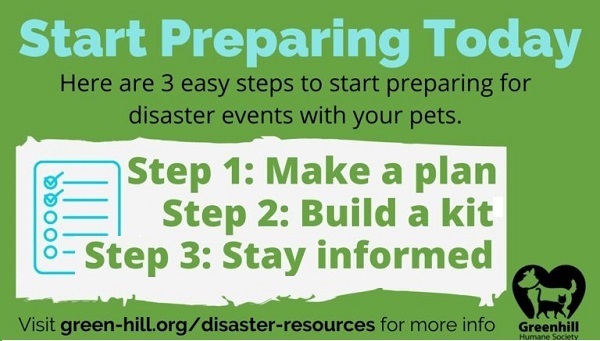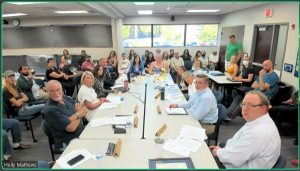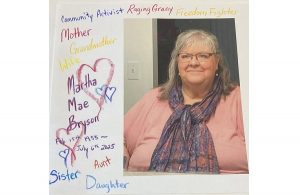Greenhill supports wildfire evacuees with innovative co-location shelters
12 min read
Southwest Hills Neighborhood Association (SHiNA) assembles a panel to discuss emergency preparedness.
Chris Jockheck (SHiNA board chair): We put together this meeting tonight on emergency and disaster preparedness and response because we’ve seen communities that have been devastated. We understand that there is always that possibility of either the big earthquake or a fire, and: What do we do? What happens at that point? How do we evacuate? Where do we go? How do we prepare for any sort of disaster, and how do we respond to it?
[00:00:40] So we put together a panel of experts—knowledgeable people—and we billed this as a community conversation. So not only will they do a presentation, but then we want to hear from you.
[00:00:55] We have Cary Lieberman, who is the executive director for the Greenhill Humane Society, and he’s going to help us understand what we do with our animals, but he also is heavily involved in the whole topic of disaster preparedness and response.
[00:01:14] And Janina Rager is a member of the police department community engagement team.
[00:01:21] Janina Rager (Eugene Police Department): My name is Janina Rager. I am a community engagement crime prevention specialist for the city of Eugene Police. I have been with the department 21 years now. I think the things that are probably on most people’s mind are going to be fires—you’re up in the South Hills—and of course, The Big One (the Cascadia Subduction Zone earthquake).
[00:01:36] So, does everyone here have their phones and any other device set up for the emergency warning tones? Okay, so we all know that Level 1-Prepare, Level 2-Get ready to go, and Level 3-Go now.
[00:01:51] Now, this is a big one. ‘Go now’ doesn’t mean I have to go get all my jewelry, I have to pack my clothes. No, it means: Go now! You should already be ready.
[00:01:59] And I think the sad thing is with the Maui fires that was kind of traumatic is, you know, when all of a sudden people looked out, saw the fires and it was very like scary, but they thought, ‘I have time,’ and people went back in their houses, not realizing how fast… So, one thing that I really like to reiterate to people is: Property can be replaced, you cannot. The main thing is you, family, pets, get out! Okay? Don’t worry about the property, that’s not important. Your lives are important.
[00:02:27] Don’t go back in the house, go. When it’s ‘Go now,’ go! Very important.
[00:02:32] Does everyone here have an evacuation plan for their house? Have you gone over it with your family members and so forth, do your kids know what to do? And have you practiced this drill?
[00:02:43] Identify alternative routes. And alternative routes aren’t necessarily always roads. They might be bike paths. They might be trails. It might be, ‘Hey, I’ve got to leave my car and take off down this path because I know it’s going to take me down to this side,’ and so forth.
[00:02:59] One of the things with Maui that was a problem is there was basically this way and that way (only two escape routes). So everybody got jammed up on the main roads. Matter of fact, three days later, people were still sitting in their cars on the main road without food and water because the traffic was so jammed back.
[00:03:16] So really contemplate the different routes, and like I said, it doesn’t have to be main roads. Those paths, etc., those can be your way to safety. So, familiarize yourself with those things.
[00:03:24] Always try to keep about a half a tank of gas in your car, okay? Because you might have to drive a ways and stuff. So, if not, you’re going to be leaving your car somewhere.
[00:03:34] Make sure all your documents in your family that are really important are in one place. And try to keep it in a secure folder. One that, latches or is together. This is birth certificates, this is Social Security cards, this is medical records, this is stuff you’re going to have a really hard time getting back if it’s a major event like a fire. Like I said, there’s very minimal things I want you grabbing, but that folder should be somewhere where you can get it pretty quickly and it has everybody’s information into it.
[00:04:03] Because rebuilding your life after is going to require a lot of that information.
[00:04:08] Make an inventory of all the valuables in your house. And the reason I say this is because after a major disaster, you’re going to have to file an insurance claim at some point. And so are thousands of other people. And so it’s good to have a list, a detailed list of everything in your house so that when you have to file those insurance claims, you have that information. Because a lot of people don’t think of that in the forefront and then you’ve got to try to figure it out afterwards.
[00:04:32] So make sure all those documents are put together in one spot, safely, not where if someone breaks in your house they can take them, but still that you can get to them quickly in case of an emergency.
[00:04:42] Have some cash in there as well, enough cash to pay for about a week’s worth of stuff. Because when the system goes down, you’re not going to be able to use ATM machines and so forth. The bank machines aren’t going to work. And so most places are only going to take money.
[00:04:56] So don’t just have three $100 bills. This is a good time to have five-dollar bills, ones, tens. Things that you can buy things with and try to get by for a week, so that you can get things you need, if necessary.
[00:05:07] Also educate yourself on a disaster plan in your workplace and schools. I mean, let’s face it, the disaster isn’t necessarily going to happen when everybody’s home together.
[00:05:17] And so, do you have kids? Do you know what the disaster plan is at their school? Do you know where the kids are going to go? What’s going to happen to them? Do they know where you’re going to go? Do you have family members that are in retirement centers and so forth? Have you thought about how you’re going to communicate with them, how you’re going to get hold of those people?
[00:05:34] So, it’s good to have a good family plan. Like: ‘Hey, it’s two in the afternoon and the big earthquake just hit. And, little Tommy’s at preschool. I’ve got a high schooler over here. I got parents over in this home. Is there a place we’re all going to meet? Is there a place where we know that we can get together, where it’s safe?’ This is something a lot of people don’t really think about, because you just kind of assume everybody’s going to be together when the bad happens. But have that plan, have a meeting place.
[00:06:00] Make sure all your family members, even your kids, know how to turn off utilities. So if a major event happens and all of a sudden you’ve got to make sure the electricity is turned off or the water or something because it’s going to cause a problem, everybody should know where are those spigots, how do we shut this stuff on and off, okay?
[00:06:15] Don’t spend a lot of time on your phone. You’re going to want to call everybody, and ‘Are you okay? Are you okay?’ If everybody’s on the phone lines trying to call family members and stuff, it causes them to jam up. And then people who really are in need of emergency services and stuff can’t get through.
[00:06:31] Well, not only does this use up time, you don’t know when you’re going to be able to charge that phone again. Close all the apps out on it, so it doesn’t burn the battery life.
[00:06:39] And additionally, if you have to get ahold of people, text. It takes less energy on your phone if you’re texting them.
[00:06:45] So, also knowing things like knowing the local organizations that perform emergency management, like the Red Cross, nonprofits, and so forth. It would be a good idea to keep those numbers in your cell phones, or if you have it somewhere, so that afterwards you have a means to get services if you need to. It’s good to know all the different emergency services that can assist you.
[00:07:07] Unless you live in a mandatory evacuation zone, plan to shelter in place if it’s safe to do so. The main thing is, if you can stay at your location, if it’s safe, do that. Because getting out and about might make it harder. Especially if we have a lot of people out and about that people are trying to find and so forth.
[00:07:25] If you live in a mandatory evacuation zone, plan with your friends and family to shelter with them at a later time too. So, if you can’t be at your house, again, plan. Have someone that you know will let you come to their location if you need to be. Have those resources set up in advance.
[00:07:42] Do you have food? At my house, we actually have some coolers, so if an emergency happens and you have to shelter in place, there’s some form of food. Okay? Be getting containers like five-gallon containers of water. Have some of those on hand.
[00:07:58] And about every three to six months, you’ll have to drain them. Water your plants with it or something like that. Refill them so you’re getting fresh water.
[00:08:08] Cary Lieberman (Greenhill Humane Society): I am Cary Lieberman from Greenhill Humane Society…I just wanted to share, as Greenhill Humane Society, what we are doing for the community for disaster response are two things. In situations like a fire response, where people are evacuated from their homes and a Red Cross shelter is set up, we will make every effort possible to be there and co-locate a shelter for animals at the same location so that you can feel safe to evacuate with your pets.
[00:08:44] You know that if you need to go into a Red Cross shelter, those pets can be right there with you. The other thing that we do is turn over our shelter that’s out on Green Hill Road, to make it available for disaster response, for intake of animals. So if you are needing to evacuate your home, and you don’t have a safe place to bring your animals, Greenhill can shelter those animals there at the shelter.
[00:09:12] We do both of these things, essentially, through the nonprofit firm that we are. So we’re not a government agency. This actually isn’t contracted work either. This is part of what we do as a nonprofit organization that is focused on pets and people.
[00:09:29] Because really what we’ve seen, was that people would not evacuate their homes if they couldn’t bring pets with them—and people and animals lost lives because of that situation. And so actually the federal government mandated that every community in this country have a disaster plan for animals, as well as people.
[00:09:48] And we have been working with our community, with Lane County, with the city of Eugene for over a decade now, creating a pathway and a plan, and unfortunately, with the Holiday Farm Fire, we had to start implementing that plan. It was the first time this community really had a large-scale evacuation.
[00:10:06] So at Level 1, we’re fielding phone calls, we’re being aware of what’s going on in the community, we’re monitoring that, we’re mostly informing people of, like, ‘Here are all the different things you can do to prepare yourself in the event that it starts to go to Level 2 or Level 3.’
[00:10:25] It takes different people different amounts of time to evacuate, right? So, mobility issues, other issues that people may have, larger families, families without cars, they will take longer to evacuate.
[00:10:42] And so at Level 1, that might mean something a little bit different for that family than a family that is more capable of fully evacuating at Level 3, because they’ve got everything ready and they have the capacity and ability to do that. And it’s important for neighbors to be aware of this.
[00:10:59] Greenhill, for instance, opens up its shelter at Level 2.
[00:11:04] Historically, the human shelters, the locations that Red Cross is set up with, have not actually allowed pets to be part of that sheltering system. And we’ve been fortunate in this community, kind of experimenting with this notion of actually housing the pets in the exact same facility that humans are located.
[00:11:27] We’re fortunate we were able to use the Lane County Fairgrounds, and the building that we were in just had a divider separating the two. It was the experience that the Red Cross had was that it was the most relaxed group of evacuees and volunteers that they had seen here locally.
[00:11:47] Or actually, around the region, because people weren’t panicked as much about the loved ones that they left behind, essentially. They were also, many of the people that are evacuating and need the Red Cross to help support them, those animals are their safety net. You know, they’re their emotional connection. And just having them nearby is comforting.
[00:12:14] You know, our experience in the Cedar Creek Fire, that was the evacuation of Oakridge. That was five days. The most recent situation with the fires in that same region, basically, there was a shelter in Lowell that was operated for ten days, and then an additional shelter that was located in more of the Oakridge area for longer than that.
[00:12:41] John Q: Southwest Hills also featured a longtime EWEB employee.
[00:12:44] Jeannine Parisi (South Eugene resident and longtime EWEB employee): You know, I’ve lived in Eugene 30 years, I’ve worked for EWEB for 20. The past three years, almost all I’ve thought about was wildfire. It has changed so dramatically for me as a South Hills neighbor. I live in this neighborhood, but also as an organization, we have pivoted so much of our resiliency and our planning work from The Big One, which we’re still investing heavily, if you see those tanks on East 40th, those are about seismic resiliency and fire suppression water for earthquakes.
[00:13:17] But a lot of our operational planning and work that we’re doing is about wildfire protection and mitigation and that has a direct impact on the work we do. Fire danger is higher and we all have a part in that. EWEB is doing its part because we don’t want to be part of a cause of a fire.
[00:13:34] We have a whole range of actions that we’re taking to keep our equipment from starting something on fire. There’s no guarantees, but we also as community members have to make sure that we are not responsible for a fire, or if something gets going in our neighborhood, that we have fire breaks, and we can control that fire as fast as possible.
[00:13:53] We’re really lucky, we have great fire protection services in our neighborhood. So, you know, compared to upriver, where it’s all kind of rural fire protection, there’s no fire hydrants, response time’s slower. In the South Hills, we’re in a much better condition in terms of fire risk, but it’s still very real.
[00:14:14] John Q: A thank-you from a Southwest Hills resident at Cascade Manor.
[00:14:17] Cascade Manor resident: I live in Cascade Manor, a retirement community right down the street from you, Cary. And I just wanted to say thank you for acknowledging some of us have mobility problems, and so it’s nice to be seen.
[00:14:32] John Q: Another participant recommended the Firewise program.
[00:14:35] Blanton Treehouse Association member: Some of our neighborhoods, the Blanton Treehouse Association location in Southpointe (Drive), have become Firewise neighborhoods, which consists of reducing flammable materials around—particularly, tree growth—around our houses. It really put us on notice that we were not safe. You know, we hadn’t created any zones around our houses that would provide protection against fires.
[00:15:09] So maybe some other neighborhoods would be interested in looking into that. Not only is it helpful to have people advise you as to what trees you need to remove or bushes or whatever, but it also I think created a sense of pride in our little cul-de-sac, that we were able to qualify for Firewise.
[00:15:32] Chris Jockheck (SHiNA board chair): I want to thank our panel. I’d like to thank all of you for coming and with your questions. I hope this is useful. And I know some of the questions will be towards the prevention and then even the long term, and we’ll be addressing those in the future. So I’d encourage you all to come to our Nov. 28 meeting, and join us and brainstorm. Help us brainstorm, be part of it, or take over! And so we can get these community conversations going.
[00:16:11] John Q: The panel also included Eugene’s new emergency management leader, Sierra Anderson, who introduced volunteers from the neighborhoods and the CERT program. They’re featured in their own segment.
[00:16:21] If you live in the Southwest Hills neighborhood, you can help the board organize the upcoming meetings. Elsewhere in Eugene and Springfield, contact the CERT program or your local neighborhood association.



